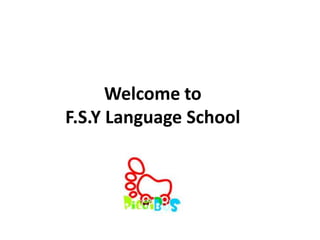1 of 3
Download to read offline



Ad
Recommended
際際滷share
際際滷shareShiyao Fu
?
F.S.Y Language School welcomes students and provides online language courses in English, Spanish, French, Japanese, Korean, and Chinese from their location in Fuxin City, Liaoning Province, China. They share their address and encourage followers as they look forward to new students.Japanese e learning center
Japanese e learning centerbluestar02357
?
This document provides information about the Japanese E-Learning Center, a company founded by Sei Kan/Qing Han that develops Japanese language e-learning systems. The company has 5 employees and is located in San Francisco, with the goal of helping more people learn Japanese quickly and effectively through their online systems. Contact information including email, address, and phone number is provided.Module01
Module01bluestar02357
?
The document discusses the Japanese-Language Proficiency Test (JLPT). It provides information on what the JLPT is, its history and growth, and revisions made to the test in 2010. The JLPT evaluates and certifies the Japanese proficiency of non-native speakers, and has five levels from easiest (N5) to most difficult (N1). It focuses on communicative competence and accurately measures proficiency through scaled scores.Module01
Module01bluestar02357
?
The document discusses the Japanese-Language Proficiency Test (JLPT), which evaluates and certifies the Japanese proficiency of non-native speakers. It provides four key points about the JLPT: 1) it focuses on communicative competence, 2) it offers five test levels from easiest to most difficult, 3) it accurately measures competency with scaled scores, and 4) it easily visualizes what skills test-takers have in Japanese listening, speaking, reading and writing for each level. The JLPT has become the largest-scale Japanese language test worldwide with over 700,000 examiners globally as of 2009.Japanese e learning center
Japanese e learning centerbluestar02357
?
This document provides information about the Japanese E-Learning Center, a company founded by Sei Kan/Qing Han that develops Japanese language e-learning systems. The company has 5 employees and is located in San Francisco, with the goal of helping more people learn Japanese quickly and effectively through their online systems. Contact information including email, address, and phone number is provided.Qualitative vs quantative research
Qualitative vs quantative researchemmas123
?
Quantitative research is considered the "gold standard" because it uses strict methodologies like experiments, surveys, and statistics to objectively measure phenomena with large random samples and eliminate bias. This allows quantitative research to draw conclusions about entire populations and test hypotheses in a controlled, repeatable manner. In contrast, qualitative research uses smaller samples and open-ended tools that can introduce more subjective researcher and participant bias and do not aim to generalize findings.More Related Content
Viewers also liked (6)
Japanese e learning center
Japanese e learning centerbluestar02357
?
This document provides information about the Japanese E-Learning Center, a company founded by Sei Kan/Qing Han that develops Japanese language e-learning systems. The company has 5 employees and is located in San Francisco, with the goal of helping more people learn Japanese quickly and effectively through their online systems. Contact information including email, address, and phone number is provided.Qualitative vs quantative research
Qualitative vs quantative researchemmas123
?
Quantitative research is considered the "gold standard" because it uses strict methodologies like experiments, surveys, and statistics to objectively measure phenomena with large random samples and eliminate bias. This allows quantitative research to draw conclusions about entire populations and test hypotheses in a controlled, repeatable manner. In contrast, qualitative research uses smaller samples and open-ended tools that can introduce more subjective researcher and participant bias and do not aim to generalize findings.Welcome to
- 1. Welcome to F.S.Y Language School